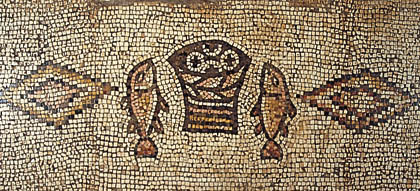I’ll suggest that the Church’s weekly communion meal is shaped at least as much, if not more so, by the resurrection meals of Jesus on that first Easter Sunday than by the Last Supper in the upper room. It’s the Resurrection Day meals that most inform the Church’s Lord’s Supper and give it its meaning. One of the main reasons is that the disciples first encountered the risen and living Lord at those meals.
The very day he walked out of the grave, Jesus made it a point to be present with his followers at the main evening meal. He showed up at mealtime.
In Mark 16, we’re told “Jesus appeared to the Eleven as they were eating.” They risen Lord is physically present with them at the table. Luke 24 says “Jesus himself stood among them.” They offered him some fish and “he ate it in their presence.” The Gospel of John is describing this same scene when it says “Jesus came and stood among them.”
Jesus is present with his followers at the Sunday meal. He is here. He is with us at the table, eating and drinking with us on the other side of the salvation work he came to do. On the other side of his death and resurrection, Jesus is present with his people at the meal.
And his physical presence provides the proof of God’s promises. It’s the proof the disciples need to know for sure that Jesus really is alive and that God is really doing everything he says he’s going to do.
In John, Jesus shows them his hands and his side. “The disciples were overjoyed when they saw the Lord.” Thomas runs his fingers along the Savior’s wounds, he touches Jesus’ scars. Jesus says, “Stop doubting and believe!” And Thomas does: “My Lord and my God!” In Mark, the disciples don’t believe the reports of Jesus’ resurrection. Twice it says they did not believe — they didn’t believe Mary and they didn’t believe the two disciples who Jesus in the country. But after the supper with the risen Lord, they do believe. The dinner provided the proof. Everything changed. “And the disciples went out and preached everywhere.”
In Luke 24, the disciples thought the resurrected Lord was a ghost or a spirit. They thought Jesus was still dead. Jesus says, “No, it’s me! Look at my hands and my feet! It is I, myself! Touch me and see! A ghost doesn’t have flesh and bones!”
“Look,” Jesus says, “I’ll prove it. Give me some of that fish.” And he ate it in their presence. And the disciples went from startled and frightened to joy and amazement. Their minds were opened, it says, and they understood everything.
It’s very easy to see why these resurrection meals carry so much weight. The risen Lord is present, he’s actually with us around the table. And it proves everything. This is not a dream or a vision, he is not a ghost or a spirit, this is not group hypnosis or wishful thinking. When Jesus appears on Sunday to eat with his followers, the realities are revealed. In Acts 10, Peter is preaching about the resurrection of Jesus. How do you know it’s real, Peter? Where’s your proof? Peter says, “We ate and drank with him after he rose from the dead!”
Yeah, the resurrection meals are loaded.
But the ultimate expression of the deep significance of these Lord’s Day suppers is found in Luke 24:13-35. This is the account of the very first of these resurrection meals, the first meal Jesus shared with his followers the day he walked out of the grave.
I’ll be breaking it down in this space over the next couple of days. In the meantime, you might read the text. You’re already familiar with this great story.
Peace,
Allan

Leave a Reply